|
|
|
Sort Order |
|
|
|
Items / Page
|
|
|
|
|
|
|
| Srl | Item |
| 1 |
ID:
130312
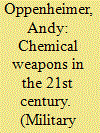

|
|
|
|
|
| Publication |
2013.
|
| Summary/Abstract |
The article focuses on chemical weapons (CW) in Syria. The August 21, 2013 mass chemical weapon bombardment in Syria is discussed. Other topics mentioned include the decommissioning of the Syrian arsenal by the United Nations' disarmament agency the Organization for the Prohibition of Chemical Weapons, the civil war in Syria, and the dismantling of Syria's capability to produce CW. Also discussed are defenses against chemical, biological, radiological and nuclear (CBRN) weapons.
|
|
|
|
|
|
|
|
|
|
|
|
|
|
|
|
| 2 |
ID:
171180
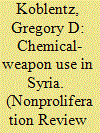

|
|
|
|
|
| Summary/Abstract |
International efforts to hold the government of President Bashar al-Assad accountable for the use of chemical weapons in the Syrian Civil War have entered a new phase. For the first time, the Organisation for the Prohibition of Chemical Weapons (OPCW), the international organization responsible for implementing the 1993 Chemical Weapons Convention, has been empowered to identify the perpetrators of chemical attacks in Syria. The Investigation and Identification Team (IIT), which was formed to conduct the OPCW’s new attribution mission, has announced its intention to investigate and identify the perpetrators of nine chemical attacks in Syria, including the April 7, 2018, attack in Douma. This article reviews recent efforts to attribute chemical attacks in Syria, describes what we know about the nine incidents to be investigated, summarizes what is known about the Syrian government officials, military commanders, and chemical-warfare scientists suspected of being responsible for these attacks, discusses what to expect during the next phase of the attribution process, and offers insights into how the international community can move beyond attribution to accountability. Accountability is necessary to provide justice for victims and to prevent future incidents by demonstrating that perpetrators of chemical attacks will be identified and punished.
|
|
|
|
|
|
|
|
|
|
|
|
|
|
|
|
| 3 |
ID:
191978
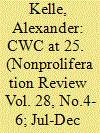

|
|
|
|
|
| Summary/Abstract |
This article analyzes the shifting focus of the Chemical Weapons Convention (CWC) during the first 25 years of its implementation, from the verification of destruction of declared chemical-weapon (CW) stockpiles to the attribution of CW use. The article identifies the repeated use of chemical weapons by Syria and the resultant creation of a new attribution norm under the CWC as a critical juncture in the regime’s evolution. Repeated calls for accountability for the use of so-called Novichok nerve agents for assassination purposes serve as the first manifestation of the new attribution norm. The article further outlines steps CWC states parties should take in the context of the Fifth CWC Review Conference in May 2023 to prepare the CW-prohibition regime for its next 25 years of operation by (1) adapting the implementation of key regime norms following the anticipated completion of CW destruction later in 2023 and (2) incorporating the investigation and attribution work of the Investigation and Identification Team into the programmatic work of the OPCW.
|
|
|
|
|
|
|
|
|
|
|
|
|
|
|
|
| 4 |
ID:
147685
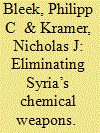

|
|
|
|
|
| Summary/Abstract |
The 2013–14 disarmament of Syria's chemical-weapons capabilities was a rare bright spot in a brutal civil war with no end in sight. The remarkable US-led, international effort to bring Damascus into the 1997 Chemical Weapons Convention, inventory its capabilities, and then verifiably destroy them is a fascinating and, to date, largely untold story. A substantial US government interagency effort centered in the Defense Department laid the diplomatic, technical, and procedural foundations for Syria's disarmament in the year prior to the August 2013 chemical-weapons attack in Ghouta that galvanized Syria's subsequent disarmament. An intrinsically interesting case, Syria's chemical-weapons disarmament has important implications for possible future WMD elimination operations elsewhere.
|
|
|
|
|
|
|
|
|
|
|
|
|
|
|
|
| 5 |
ID:
173022
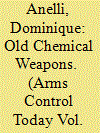

|
|
|
|
|
| Summary/Abstract |
The global inventory of chemical weapons was once enormous, especially in the United States and Soviet Union, but today 98 percent of them have been destroyed. Most of this destruction took place after the Chemical Weapons Convention (CWC) took effect in 1997, and the treaty’s implementation body, the Organisation for the Prohibition of Chemical Weapons (OPCW), has verified the elimination process.
|
|
|
|
|
|
|
|
|
|
|
|
|
|
|
|
| 6 |
ID:
155593
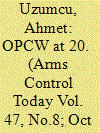

|
|
|
|
|
| Summary/Abstract |
This year marks the 20th anniversary of the entry into force of the Chemical Weapons Convention and the founding of the Organisation for the Prohibition of Chemical Weapons (OPCW). Today, the convention remains the foundation of the international community’s commitment to eliminate the scourge of chemical weapons.
|
|
|
|
|
|
|
|
|
|
|
|
|
|
|
|
|
|
|
|
|